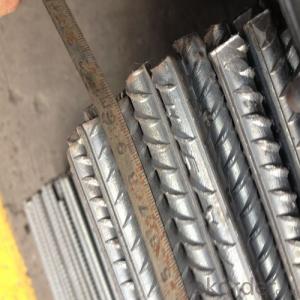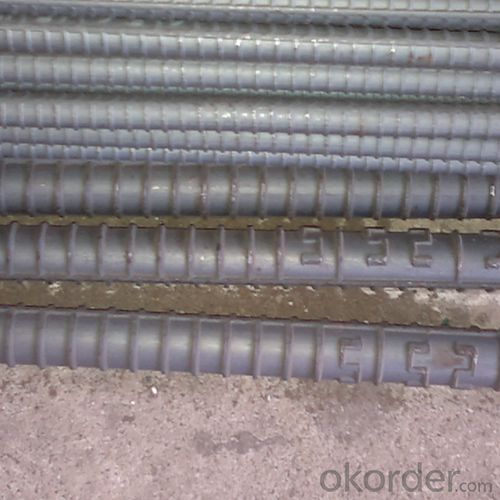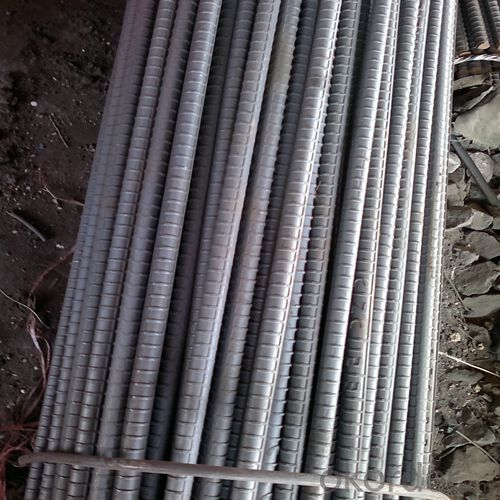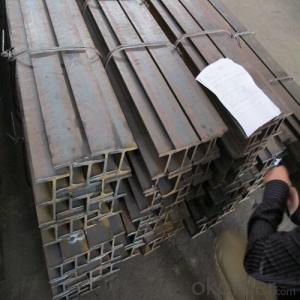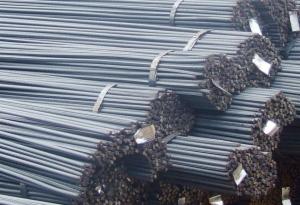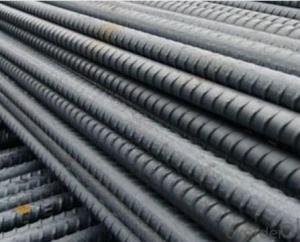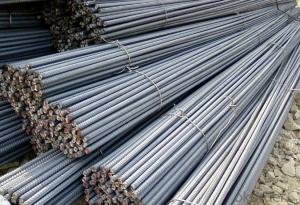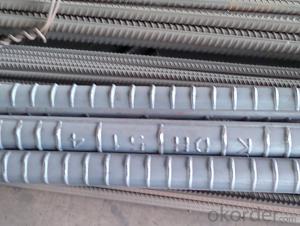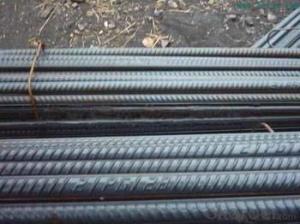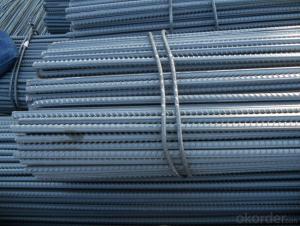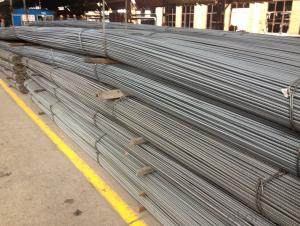Deformed Steel Bar HRB4000 HRB500 ASTM A615 GR40/GR60
- Loading Port:
- Tianjin
- Payment Terms:
- TT or LC
- Min Order Qty:
- 100 m.t.
- Supply Capability:
- 40000 m.t./month
OKorder Service Pledge
OKorder Financial Service
You Might Also Like
Product Description:
OKorder is offering Deformed Steel Bar HRB4000 HRB500 ASTM A615 GR40/GR60 at great prices with worldwide shipping. Our supplier is a world-class manufacturer of steel, with our products utilized the world over. OKorder annually supplies products to European, North American and Asian markets. We provide quotations within 24 hours of receiving an inquiry and guarantee competitive prices.
Product Applications:
Deformed Steel Bar HRB4000 HRB500 ASTM A615 GR40/GR60 are ideal for structural applications and are widely used in the construction of buildings and bridges, and the manufacturing, petrochemical, and transportation industries.
Product Advantages:
OKorder's Deformed Steel Bar HRB4000 HRB500 ASTM A615 GR40/GR60 are durable, strong, and resist corrosion.
Main Product Features:
· Premium quality
· Prompt delivery & seaworthy packing (30 days after receiving deposit)
· Corrosion resistance
· Can be recycled and reused
· Mill test certification
· Professional Service
· Competitive pricing
Product Specifications:
Standard | GB | HRB400 | |
Diameter | 6mm,8mm,10mm,12mm,14mm,16mm,18mm,20mm, 22mm,25mm,28mm,32mm,36mm,40mm,50mm | ||
Length | 6M, 9M,12M or as required | ||
Place of origin | Hebei, China mainland | ||
Advantages | exact size, regular package, chemical and mechanical properties are stable. | ||
Type | Hot rolled deformed steel bar | ||
Brand name | DRAGON | ||
Chemical Composition: (Please kindly find our chemistry of our material based on HRB500 as below for your information)
Grade | Technical data of the original chemical composition (%) | ||||||
C | Mn | Si | S | P | V | ||
HRB400 | ≤0.25 | ≤1.60 | ≤0.80 | ≤0.045 | ≤0.045 | 0.04-0.12 | |
Physical capability | |||||||
Yield Strength (N/cm²) | Tensile Strength (N/cm²) | Elongation (%) | |||||
≥400 | ≥570 | ≥14 | |||||
Theoretical weight and section area of each diameter as below for your information:
Diameter(mm) | Section area (mm²) | Mass(kg/m) | Weight of 12m bar(kg) |
6 | 28.27 | 0.222 | 2.664 |
8 | 50.27 | 0.395 | 4.74 |
10 | 78.54 | 0.617 | 7.404 |
12 | 113.1 | 0.888 | 10.656 |
14 | 153.9 | 1.21 | 14.52 |
16 | 201.1 | 1.58 | 18.96 |
18 | 254.5 | 2.00 | 24 |
20 | 314.2 | 2.47 | 29.64 |
22 | 380.1 | 2.98 | 35.76 |
25 | 490.9 | 3.85 | 46.2 |
28 | 615.8 | 4.83 | 57.96 |
32 | 804.2 | 6.31 | 75.72 |
36 | 1018 | 7.99 | 98.88 |
40 | 1257 | 9.87 | 118.44 |
50 | 1964 | 15.42 | 185.04 |
Usage and Applications of HRB400 Deformed Steel Bar:
Deformed bar is widely used in buildings, bridges, roads and other engineering construction. Big to highways, railways, bridges, culverts, tunnels, public facilities such as flood control, dam, small to housing construction, beam, column, wall and the foundation of the plate, deformed bar is an integral structure material. With the development of world economy and the vigorous development of infrastructure construction, real estate, the demand for deformed bar will be larger and larger..
Packaging & Delivery of HRB400 Deformed Steel Bar:
Packaging Detail: products are packed in bundle and then shipped by container or bulk vessel, deformed bar is usually naked strapping delivery, when storing, please pay attention to moisture proof. The performance of rust will produce adverse effect.
Each bundle weight: 2-3MT, or as required
Payment term: TT or L/C
Delivery Detail: within 45 days after received advanced payment or LC.
Label: to be specified by customer, generally, each bundle has 1-2 labels
Trade terms: FOB, CFR, CIF
FAQ:
Q1: Why buy Materials & Equipment from OKorder.com?
A1: All products offered byOKorder.com are carefully selected from China's most reliable manufacturing enterprises. Through its ISO certifications, OKorder.com adheres to the highest standards and a commitment to supply chain safety and customer satisfaction.
Q2: How do we guarantee the quality of our products?
A2: We have established an advanced quality management system which conducts strict quality tests at every step, from raw materials to the final product. At the same time, we provide extensive follow-up service assurances as required.
Q3: How soon can we receive the product after purchase?
A3: Within three days of placing an order, we will begin production. The specific shipping date is dependent upon international and government factors, but is typically 7 to 10 workdays.
Q4: What makes stainless steel stainless?
A4: Stainless steel must contain at least 10.5 % chromium. It is this element that reacts with the oxygen in the air to form a complex chrome-oxide surface layer that is invisible but strong enough to prevent further oxygen from "staining" (rusting) the surface. Higher levels of chromium and the addition of other alloying elements such as nickel and molybdenum enhance this surface layer and improve the corrosion resistance of the stainless material.
Q5: Can stainless steel rust?
A5: Stainless does not "rust" as you think of regular steel rusting with a red oxide on the surface that flakes off. If you see red rust it is probably due to some iron particles that have contaminated the surface of the stainless steel and it is these iron particles that are rusting. Look at the source of the rusting and see if you can remove it from the surface.
Images:
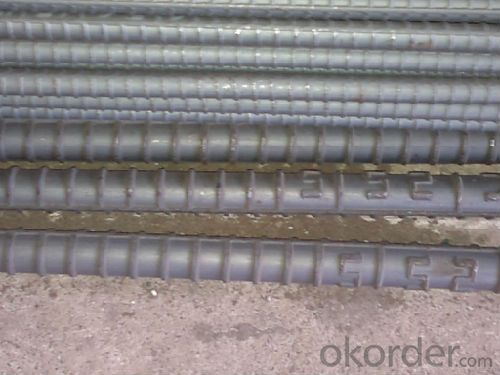
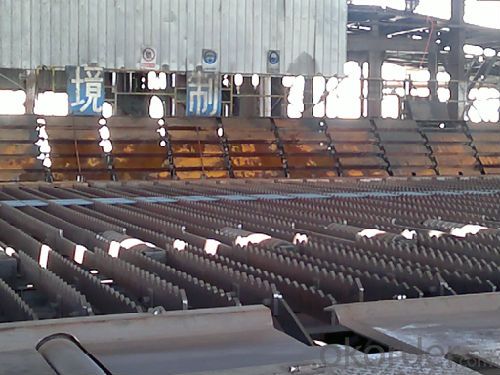

- Q: How are steel rebars handled and stored on construction sites?
- Construction projects that require reinforced concrete structures rely on steel rebars, which are also known as reinforcing bars. Ensuring the quality and safety of these rebars when handling and storing them on construction sites is of utmost importance. Upon delivery to the construction site, the steel rebars must undergo inspection for any signs of damage or corrosion. If any rebars are found to be damaged, they should be discarded as they can compromise the project's structural integrity. Additionally, the rebars should be checked for proper labeling, including grade, size, and other specifications. Mechanical lifting equipment, such as cranes or forklifts, is typically used to handle steel rebars. It is crucial to use appropriate lifting tools to prevent mishandling or accidents that could result in injuries. The rebars should be lifted vertically to avoid bending or distortion. Once lifted, the steel rebars should be stored in a designated area called a rebar yard. This yard should be clean, well-drained, and organized to prevent potential damage or corrosion. The rebars should be stacked horizontally on leveled ground, ensuring they do not come into direct contact with the soil or water to avoid rusting. To prevent the rebars from rolling or falling, they should be securely tied together using binding wires or steel bands. This practice not only helps maintain the order and stability of the stored rebars but also prevents accidental damage by keeping them away from other construction materials, machinery, or equipment. Proper storage also involves protecting the rebars from adverse weather conditions. Waterproof tarpaulins or plastic sheets should be used to cover the rebars, preventing moisture absorption and corrosion. Adequate ventilation is necessary to avoid moisture accumulation, which can lead to rusting. Regular inspections of the stored rebars are crucial to identify any signs of damage or deterioration. If any rebars are found to be damaged or rusty, they should be promptly removed and replaced to preserve the structural integrity of the construction project. In conclusion, the handling and storage of steel rebars on construction sites require careful attention. Suitable lifting equipment should be used during handling, and a clean and organized rebar yard is necessary for storage. Regular inspections and maintenance are essential to ensure the rebars' quality and prevent any compromise to the construction project's structural integrity.
- Q: How do steel rebars affect the overall crack control of concrete?
- Steel rebars can significantly enhance the crack control of concrete. By providing tensile strength to the concrete, rebars help distribute and resist the formation of cracks. They act as reinforcement, preventing cracks from propagating and limiting their width, thus enhancing the overall durability and structural integrity of the concrete.
- Q: How do steel rebars affect the overall flexibility of concrete structures?
- Concrete structures are greatly improved by the addition of steel rebars. These rebars increase the tensile strength of concrete, making it more resistant to cracking and deformation when under load. Concrete is strong when compressed, but weak when pulled. By incorporating steel rebars into the concrete, it creates a composite material that combines the strength of concrete with the strength of steel. The rebars act as reinforcement by distributing the load across the structure and preventing the concrete from failing when pulled. This reinforcement helps to limit the formation and spread of cracks, as the rebars bear the stress and prevent the concrete from completely separating. As a result, the presence of rebars significantly enhances the flexibility and ductility of the concrete structure, allowing it to withstand different forces and movements without catastrophic failure. Furthermore, steel rebars also improve the stability of concrete elements. They provide additional strength and support, preventing excessive deflection, bending, or buckling of the structure. This ensures that the structure can withstand external loads and environmental conditions. The increased flexibility and stability contribute to the durability and longevity of the concrete structure, making it more resistant to factors such as seismic activity, temperature changes, and shrinkage. In conclusion, steel rebars are essential in enhancing the overall flexibility of concrete structures. They provide the necessary tensile strength to counteract the weakness of concrete in tension, preventing cracking and deformation. By reinforcing the structure, steel rebars improve its stability, durability, and ability to withstand various forces and movements, ensuring the integrity and longevity of the concrete elements.
- Q: How do steel rebars contribute to the load-bearing capacity of concrete slabs?
- Steel rebars contribute to the load-bearing capacity of concrete slabs by providing reinforcement and increasing the overall strength and durability of the structure. As concrete is strong in compression but weak in tension, steel rebars are embedded within the concrete to counteract tension forces. The rebars absorb and distribute the tensile stresses, preventing the concrete from cracking or failing under heavy loads. This combination of concrete and steel rebars creates a reinforced structure that can bear more weight and withstand various external forces, ensuring the integrity and safety of the concrete slab.
- Q: How do steel rebars affect the durability of concrete in freeze-thaw cycles?
- Steel rebars can greatly enhance the durability of concrete in freeze-thaw cycles. When concrete is exposed to freezing and thawing conditions, it undergoes a cycle of expansion and contraction. During freezing, water inside the concrete pores freezes and expands, exerting pressure on the surrounding concrete matrix. This expansion can lead to cracks and deterioration of the concrete. However, the presence of steel rebars within the concrete can help mitigate these issues. Steel has a much lower coefficient of thermal expansion compared to concrete, which means it does not expand and contract as much with temperature changes. This property allows the steel rebars to absorb the stresses generated during freeze-thaw cycles, preventing significant damage to the concrete structure. Additionally, steel rebars also provide reinforcement to the concrete, increasing its overall strength and toughness. This reinforcement helps to distribute the stresses caused by freeze-thaw cycles more evenly throughout the concrete, reducing the likelihood of cracks forming or propagating. Furthermore, steel rebars act as a barrier against water penetration into the concrete. Moisture is one of the main factors that contribute to freeze-thaw damage. The steel rebars help to create a more impermeable concrete structure by reducing the size and quantity of cracks, preventing water from entering and causing further deterioration. In summary, steel rebars play a crucial role in enhancing the durability of concrete in freeze-thaw cycles. Their ability to absorb stresses, reinforce the concrete, and prevent water penetration significantly reduces the potential for damage and extends the lifespan of the concrete structure.
- Q: How do steel rebars affect the seismic performance of a structure?
- Steel rebars have a significant impact on the seismic performance of a structure. The primary role of steel rebars is to reinforce concrete and enhance its strength and ductility. This reinforcement plays a crucial role in mitigating the damaging effects of seismic activity. During an earthquake, a structure experiences various forces, such as lateral forces, shear forces, and bending moments. These forces can cause the structure to deform, crack, or even collapse. However, steel rebars provide resistance against these forces and help maintain the integrity of the structure. The presence of steel rebars increases the tensile strength of concrete, which is otherwise weak in tension. This enhanced tensile strength allows the structure to better withstand the lateral movement induced by seismic waves. By distributing the forces more evenly, the rebars help to reduce the formation and propagation of cracks, limiting the potential for structural failure. Moreover, steel rebars increase the ductility of the structure. Ductility refers to the ability of a material to undergo deformation without breaking. During an earthquake, the ground shaking can cause the structure to deform and oscillate. Steel rebars allow the structure to absorb and dissipate energy, reducing the likelihood of sudden failure. This ductile behavior is crucial in earthquake-prone regions as it provides warning signs of potential structural distress, allowing occupants to evacuate safely. Furthermore, steel rebars can be strategically placed in critical areas of a structure, such as the beam-column joints, which are highly vulnerable during seismic events. The proper detailing and configuration of rebars in these areas can significantly improve the seismic performance by strengthening the connections and preventing premature failure. In summary, steel rebars play a crucial role in enhancing the seismic performance of a structure. They increase the tensile strength of concrete, improve ductility, reduce crack formation, and strengthen critical areas. These factors collectively contribute to a more resilient structure that can better withstand and absorb the forces generated during an earthquake, ultimately ensuring the safety and stability of the building and its occupants.
- Q: How are steel rebars protected against mechanical damage during construction?
- Steel rebars are protected against mechanical damage during construction through various methods. One common method is by using protective covers or sleeves made of materials such as plastic or rubber. These covers are placed over the rebars to create a physical barrier, preventing them from being directly exposed to potential sources of damage, such as heavy machinery or construction equipment. Another method of protection is by using rebar caps or safety caps. These caps are designed to fit over the ends of the rebars, providing an extra layer of protection against mechanical damage. They help to prevent the rebars from being bent, crushed, or damaged by accidental impacts. In addition to physical protection, rebars can also be protected against mechanical damage through proper storage and handling. It is important to store rebars in a designated area that is free from any potential sources of damage, such as sharp objects or heavy materials. When handling rebars, workers should use proper lifting techniques and avoid dragging them on rough surfaces, as this can cause scratches or other forms of damage. Furthermore, during construction, rebars are often inspected regularly to ensure that they are not damaged or compromised. Any rebars that show signs of damage, such as bends, cracks, or deformations, are typically replaced to maintain the structural integrity of the construction project. By implementing these protective measures, steel rebars can be safeguarded against mechanical damage during construction, ensuring their effectiveness in providing strength and reinforcement to the structures they are used in.
- Q: Are steel rebars resistant to lightning strikes?
- No, steel rebars are not inherently resistant to lightning strikes.
- Q: Can steel rebars be used in the construction of data centers and IT facilities?
- Yes, steel rebars can be used in the construction of data centers and IT facilities. Steel rebars are commonly used in construction projects to enhance the strength and durability of concrete structures. In the case of data centers and IT facilities, where robust construction is crucial, steel rebars can provide the necessary reinforcement to ensure the integrity and safety of the buildings.
- Q: What are the guidelines for repairing or replacing corroded steel rebars in existing structures?
- The guidelines for repairing or replacing corroded steel rebars in existing structures vary depending on the severity of the corrosion and the specific requirements of the project. However, there are some general guidelines that can be followed: 1. Assessment: Before proceeding with any repairs or replacements, a thorough assessment of the corrosion damage should be conducted. This may involve visual inspections, non-destructive testing, or even laboratory analysis of samples taken from the rebars. 2. Safety: Safety should always be the top priority when working with corroded rebars. Adequate precautions should be taken to ensure the safety of workers and surrounding areas. This may include the use of personal protective equipment and ensuring a stable work environment. 3. Determine the extent of corrosion: It is important to determine the extent of corrosion and whether it has affected the structural integrity of the rebars. This can help in deciding whether repair or replacement is necessary. 4. Repair methods: Depending on the severity of corrosion, various repair methods can be employed. These may include removing the corroded portion of the rebar and applying a corrosion inhibitor or protective coating, or using electrochemical techniques such as cathodic protection to prevent further corrosion. 5. Replacement: If the corrosion damage is extensive and repair is not feasible, the corroded rebars may need to be replaced. The replacement rebars should be of the same or higher grade and should be properly anchored to maintain the structural integrity of the existing structure. 6. Design considerations: When repairing or replacing corroded rebars, it is important to consider the design requirements of the structure. The repaired or replaced rebars should meet the necessary load-bearing capacity and should be properly integrated into the existing structure. 7. Quality control: Throughout the repair or replacement process, rigorous quality control measures should be implemented to ensure the effectiveness and durability of the repairs. This may include regular inspections, testing, and monitoring of the repaired or replaced rebars. It is important to note that these guidelines are general recommendations and should be tailored to the specific circumstances and requirements of each project. Therefore, it is advisable to consult with a structural engineer or a professional experienced in repairing corroded steel rebars for a more accurate and detailed guideline.
Send your message to us
Deformed Steel Bar HRB4000 HRB500 ASTM A615 GR40/GR60
- Loading Port:
- Tianjin
- Payment Terms:
- TT or LC
- Min Order Qty:
- 100 m.t.
- Supply Capability:
- 40000 m.t./month
OKorder Service Pledge
OKorder Financial Service
Similar products
Hot products
Hot Searches
Related keywords
